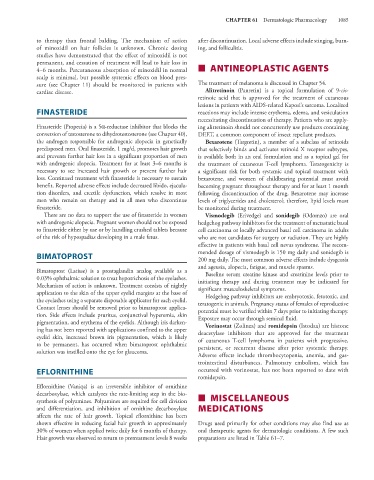Page 1099 - Basic _ Clinical Pharmacology ( PDFDrive )
P. 1099
CHAPTER 61 Dermatologic Pharmacology 1085
to therapy than frontal balding. The mechanism of action after discontinuation. Local adverse effects include stinging, burn-
of minoxidil on hair follicles is unknown. Chronic dosing ing, and folliculitis.
studies have demonstrated that the effect of minoxidil is not
permanent, and cessation of treatment will lead to hair loss in
4–6 months. Percutaneous absorption of minoxidil in normal ■ ANTINEOPLASTIC AGENTS
scalp is minimal, but possible systemic effects on blood pres-
sure (see Chapter 11) should be monitored in patients with The treatment of melanoma is discussed in Chapter 54.
cardiac disease. Alitretinoin (Panretin) is a topical formulation of 9-cis-
retinoic acid that is approved for the treatment of cutaneous
lesions in patients with AIDS-related Kaposi’s sarcoma. Localized
FINASTERIDE reactions may include intense erythema, edema, and vesiculation
necessitating discontinuation of therapy. Patients who are apply-
Finasteride (Propecia) is a 5α-reductase inhibitor that blocks the ing alitretinoin should not concurrently use products containing
conversion of testosterone to dihydrotestosterone (see Chapter 40), DEET, a common component of insect repellant products.
the androgen responsible for androgenic alopecia in genetically Bexarotene (Targretin), a member of a subclass of retinoids
predisposed men. Oral finasteride, 1 mg/d, promotes hair growth that selectively binds and activates retinoid X receptor subtypes,
and prevents further hair loss in a significant proportion of men is available both in an oral formulation and as a topical gel for
with androgenic alopecia. Treatment for at least 3–6 months is the treatment of cutaneous T-cell lymphoma. Teratogenicity is
necessary to see increased hair growth or prevent further hair a significant risk for both systemic and topical treatment with
loss. Continued treatment with finasteride is necessary to sustain bexarotene, and women of childbearing potential must avoid
benefit. Reported adverse effects include decreased libido, ejacula- becoming pregnant throughout therapy and for at least 1 month
tion disorders, and erectile dysfunction, which resolve in most following discontinuation of the drug. Bexarotene may increase
men who remain on therapy and in all men who discontinue levels of triglycerides and cholesterol; therefore, lipid levels must
finasteride. be monitored during treatment.
There are no data to support the use of finasteride in women Vismodegib (Erivedge) and sonidegib (Odomzo) are oral
with androgenic alopecia. Pregnant women should not be exposed hedgehog pathway inhibitors for the treatment of metastatic basal
to finasteride either by use or by handling crushed tablets because cell carcinoma or locally advanced basal cell carcinoma in adults
of the risk of hypospadias developing in a male fetus. who are not candidates for surgery or radiation. They are highly
effective in patients with basal cell nevus syndrome. The recom-
BIMATOPROST mended dosage of vismodegib is 150 mg daily and sonidegib is
200 mg daily. The most common adverse effects include dysgeusia
and ageusia, alopecia, fatigue, and muscle spasms.
Bimatoprost (Latisse) is a prostaglandin analog available as a Baseline serum creatine kinase and creatinine levels prior to
0.03% ophthalmic solution to treat hypotrichosis of the eyelashes. initiating therapy and during treatment may be indicated for
Mechanism of action is unknown. Treatment consists of nightly significant musculoskeletal symptoms.
application to the skin of the upper eyelid margins at the base of Hedgehog pathway inhibitors are embryotoxic, fetotoxic, and
the eyelashes using a separate disposable applicator for each eyelid. teratogenic in animals. Pregnancy status of females of reproductive
Contact lenses should be removed prior to bimatoprost applica- potential must be verified within 7 days prior to initiating therapy.
tion. Side effects include pruritus, conjunctival hyperemia, skin Exposure may occur through seminal fluid.
pigmentation, and erythema of the eyelids. Although iris darken- Vorinostat (Zolinza) and romidepsin (Istodax) are histone
ing has not been reported with applications confined to the upper deacetylase inhibitors that are approved for the treatment
eyelid skin, increased brown iris pigmentation, which is likely of cutaneous T-cell lymphoma in patients with progressive,
to be permanent, has occurred when bimatoprost ophthalmic persistent, or recurrent disease after prior systemic therapy.
solution was instilled onto the eye for glaucoma.
Adverse effects include thrombocytopenia, anemia, and gas-
trointestinal disturbances. Pulmonary embolism, which has
EFLORNITHINE occurred with vorinostat, has not been reported to date with
romidepsin.
Eflornithine (Vaniqa) is an irreversible inhibitor of ornithine
decarboxylase, which catalyzes the rate-limiting step in the bio-
synthesis of polyamines. Polyamines are required for cell division ■ MISCELLANEOUS
and differentiation, and inhibition of ornithine decarboxylase MEDICATIONS
affects the rate of hair growth. Topical eflornithine has been
shown effective in reducing facial hair growth in approximately Drugs used primarily for other conditions may also find use as
30% of women when applied twice daily for 6 months of therapy. oral therapeutic agents for dermatologic conditions. A few such
Hair growth was observed to return to pretreatment levels 8 weeks preparations are listed in Table 61–7.

